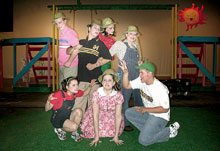Play centers on freedom of expression

Clockwise from top left, Joey Fletcher, David Pearson, Shannon Martinous, Stephanie Harter, Dusty Wooldridge, Robyn Eddy and Rachel Weisensee are acting in Free to Be … You and Me. The play centers on being one´s own person and being happy.
Big guys in pink, girls playing with trucks and jocks playing with dolls are just some of the role reversals portrayed in Free to Be … You and Me.
The show, being put on by the Missouri Southern Theatre and Missouri Show-Me Celebration Company, will have its last two performances for schools Friday before its public shows begin at 2:30 p.m. on Saturday and Sunday in Taylor Auditorium.
For this show, student IDs will not be accepted for admittance.
Tickets are $1 for adults and 50 cents for children 12 and under.
The message of the children’s musical is one of acceptance and freedom.
“No one else can tell you what you are,” said Gerrie-Ellen Johnston, director and choreographer. “It’s ridding oneself of gender-linked professions and being free and letting both sides, feminine and masculine, come out.”
Erina Parks, senior theatre major and stage manager, thinks the subject matter of race, gender and sex are particularly relevant to the times.
“Things are happening and people don’t really know what to do, which way to go,” Parks said.
The actors, all of whom are Southern students, play children. Parks believes the set, a playground with slides, a sandbox, monkey bars and other equipment, helped the actors find their inner child.
“When they first started, it was like, ‘OK, we’re grown,’ in a sense, but now they’ve just learned to let their inhibitions go,” Parks said. “They just go with it, and I think they’re having too much fun.”
Though she said the set is simple, Parks thinks it doesn’t need to be elaborate with the way the props are used.
“They make it bigger than what it is,” Parks said. “They don’t look at it for face value. They take it for everything they can use it for.”
Parks said the show is more exciting with children in the audience.
“I think the kids are what make the show,” she said. “And so mainly, the Wednesday, Thursday and Friday shows, there’s that excitement, because kids aren’t ashamed of the things they do.”
Parks said sometimes the older crowds take more work to perform.
“Being older and mature you’re like, ‘hmm, I’ve got to act this way because I’m an adult,'” Parks said. “But with this show, it’s like, so what if you like cartoons and stuff like that, that’s fine, you know. If you want to yell and cheer with the kids, do that.”
Johnston and Parks agreed they want children to interact with the show. The audience is even asked to participate.
“At the end, there are selected rows where they get the kids to dance around the auditorium to ‘Free to Be,'” Johnston said.
She said the show is important for parents to show them to expose them to new ideas.
“It’s entertaining,” Johnston said. “There’s music, and it may even educate the parents — to liberate the parents a bit, as well.”
Overall, she wants the audience to leave with one thing.
“A land of freedom,” Johnston said. “We want them to be uplifted and free of certain restrictions that perhaps they put on themselves.”
Your donation will support the student journalists of Missouri Southern State University. Your contribution will allow us to purchase equipment and cover our annual website hosting costs.



























